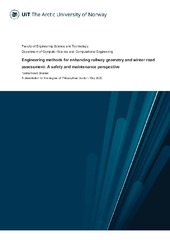| dc.contributor.advisor | Doulgeris, Anthony P. | |
| dc.contributor.advisor | Hughes, Nick | |
| dc.contributor.author | Skogvold, Øystein Fredriksen | |
| dc.date.accessioned | 2019-07-15T11:04:04Z | |
| dc.date.available | 2019-07-15T11:04:04Z | |
| dc.date.issued | 2019-05-31 | |
| dc.description.abstract | Sea ice thickness is an important parameter for modelling the sea ice mass
balance, momentum and gas exchanges, and global energy budget. The interest
of studies into thin sea ice has increased as trends in recent years show
a increasing abundance in thin first year ice. Existing thin sea ice thickness
products operate at resolutions down to 750 meters. Very high resolution (less
than 100 meters) retrieval of sea ice parameters is of particular interest due
to maritime navigation and model parametrization of physical processes at
meter-scaled resolutions that usually requires in-situ measurements.
The Norwegian Meteorological Institute provided a 500 meter resolution thin
sea ice thickness product developed by the Norwegian Computing Centre
for the Norwegian Space Agency’s "Sentinel4ThinIce" project. The product is
derived from Sentinel-3’s SLSTR sensor. Using overlapping multispectral optical
data from Sentinel-2’s MultiSpectral Instrument at metre-scaled resolutions,
we retrieved multiple regression models for thin sea ice thickness for Sentinel-2
data. The models included three univariate models for three different spectral
band combinations using non-linear least squares method, and one multivariate
model for three different band reflectance data-sets using a gradient boosting
regression tree.
The optical band reflectance data increased monotonically with sea ice thickness
and saturated for thicker ice, proving a clear correlation between thin sea ice
thickness and Sentinel-2’s band reflectance. The multivariate model produces
overall best results compared to the univariate models. The reliability of the
models couldn’t be trusted due to inaccurate atmospheric correction procedures
and not enough temporal and geographical variance in the data-set. Proper
calibration of Sentinel-2 data is of high priority in order to extend Sentinel-2’s
platform further into Arctic research. | en_US |
| dc.identifier.uri | https://hdl.handle.net/10037/15758 | |
| dc.language.iso | eng | en_US |
| dc.publisher | UiT Norges arktiske universitet | en_US |
| dc.publisher | UiT The Arctic University of Norway | en_US |
| dc.rights.accessRights | openAccess | en_US |
| dc.rights.holder | Copyright 2019 The Author(s) | |
| dc.rights.uri | https://creativecommons.org/licenses/by-nc-sa/4.0 | en_US |
| dc.rights | Attribution-NonCommercial-ShareAlike 4.0 International (CC BY-NC-SA 4.0) | en_US |
| dc.subject.courseID | FYS-3931 | |
| dc.subject | VDP::Mathematics and natural science: 400::Physics: 430::Electromagnetism, acoustics, optics: 434 | en_US |
| dc.subject | VDP::Matematikk og Naturvitenskap: 400::Fysikk: 430::Elektromagnetisme, akustikk, optikk: 434 | en_US |
| dc.subject | VDP::Mathematics and natural science: 400::Mathematics: 410::Analysis: 411 | en_US |
| dc.subject | VDP::Matematikk og Naturvitenskap: 400::Matematikk: 410::Analyse: 411 | en_US |
| dc.subject | VDP::Mathematics and natural science: 400::Mathematics: 410::Statistics: 412 | en_US |
| dc.subject | VDP::Matematikk og Naturvitenskap: 400::Matematikk: 410::Statistikk: 412 | en_US |
| dc.subject | Remote Sensing | en_US |
| dc.subject | Multispectral data | en_US |
| dc.subject | Thin sea ice thickness | en_US |
| dc.subject | Regression | en_US |
| dc.subject | Machine Learning | en_US |
| dc.title | Arctic Thin Sea Ice Thickness Regression Models for Sentinel-2 | en_US |
| dc.type | Master thesis | en_US |
| dc.type | Mastergradsoppgave | en_US |


 English
English norsk
norsk



